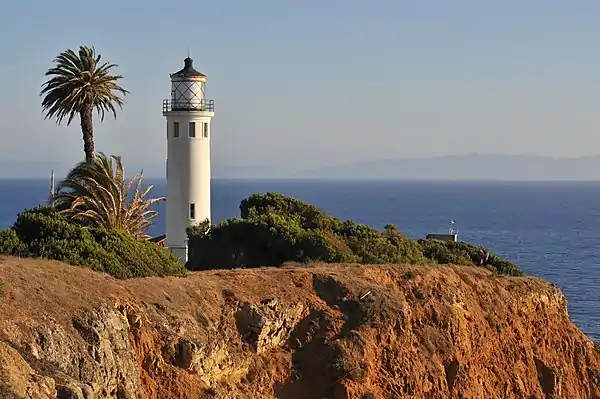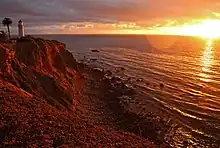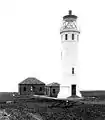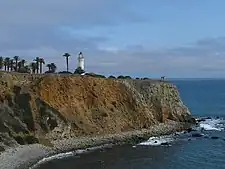Point Vicente Lighthouse
Point Vicente Lighthouse is a lighthouse in Rancho Palos Verdes, California, United States, north of Los Angeles Harbor. It is 67 feet (20 m) tall and stands on a cliff with a height of 130 feet (40 m).[4] It is between Point Loma Lighthouse to the south and Point Conception Lighthouse to the north. The lighthouse was added to the National Register of Historic Places in 1980.[4] The lighthouse is owned by the United States federal government and is managed by the United States Coast Guard. It is not usually open to the public, but the Coast Guard Auxiliary run tours once per month and it is used annually for the city's "Whale of a Day" festival.[5]
 Point Vicente Lighthouse | |
| Location | Point Vincente Rancho Palos Verdes California United States |
|---|---|
| Coordinates | 33.741867°N 118.410738°W |
| Tower | |
| Constructed | 1926 |
| Foundation | concrete base |
| Construction | reinforced concrete tower |
| Automated | 1973 |
| Height | 67 feet (20 m) |
| Shape | cylindrical tower with balcony and lantern |
| Markings | white tower, black lantern |
| Operator | United States Coast Guard[1][2] |
| Heritage | National Register of Historic Places listed place |
| Light | |
| Focal height | 155 feet (47 m) |
| Lens | Third order Fresnel lens by Barbier, Bernard and Turenne |
| Range | 24 nautical miles (44 km; 28 mi) |
| Characteristic | Fl (2) W 20s. |
Point Vicente Lighthouse | |
| Area | 17.8 acres (7.2 ha) |
| Built | 1926 |
| NRHP reference No. | 80000808[3] |
| Added to NRHP | October 31, 1980 |

History
Point Vicente Lighthouse was built in 1926, following years of complaints by shippers about the dangerous waters around the Palos Verdes peninsula. It was constructed using a Parisian Fresnel lens with a width of 5 feet (1.5 m), which had been in use in Alaska since its construction in 1886.[6] In 1934 the Long Beach Radio Station opened in a neighboring building, which was used to monitor for distress signals.[4] The light source was dimmed to just 25 watts during World War II to avoid aiding the enemy.[6] It was automated in 1971, and the radio station was closed in 1980.[4] In 2015, the Coast Guard announced its intention to replace the original third order lens with an LED light with a 14 nm range, replacing the current light and lens.[7] In February 2019 the lens was removed from the light room.
The Point Vicente Lighthouse is just north of the entrances to the Los Angeles/Long Beach Harbors. It was operated and maintained by the United States Lighthouse Service prior to that Service being merged with the U.S. Coast Guard, which was delegated all aid-to-navigation responsibilities in 1939. The lighthouse was manned until 1971 when it was automated by a remote electronic aids-to-navigation monitoring system.
The white cylindrical tower is 67 feet (20 m) tall,[8] and the masonry structure is built on the edge of a 130-foot (40 m) cliff. This places the center of the lantern 185 feet (56 m) above the ocean. The Coast Guard Light List[9] specifies its light characteristic as being a pair of two white flashes, repeating that pair every 20 seconds. An emergency light of reduced intensity operates if the main light is extinguished.
The most striking feature in the lighthouse was the classical third-order rotating Fresnel Lens located in the lantern. This particular lens was manufactured around 1910 in Paris, France, by Barbier, Benard, et Turenne, the oldest lens making company in the world. This lens is made up of hand-ground prisms held in place by a cast brass frame. The prisms and frame represent an excellent example of the precision achieved by optical scientists and the lens making art in utilizing the known principles and properties of light. When it was active, the 1.1 million candlepower-beam had a nominal (clear weather) visible range of 24 nautical miles (44 km; 28 mi). Now removed from the lantern room, the lens is on display at the Point Vicente Interpretive Center.[10][11]
This lighthouse once incorporated a pleasant-sounding foghorn to audibly warn ships during times of low visibility which are common to the area. The foghorn was dismantled in the early 2000s.
Keepers
- Head
- George W. L'Hommedieu (1925–1930)
- Anton Trittinger (1930–1945)
- Joseph May (1945–1955)[12]
Modern day usage
The Point Vicente Lighthouse that is typically open for tours on the second Saturday of each month, 10am to 3pm PST. is currently closed. The lighthouse and grounds are federal property owned and operated by the United States Coast Guard.
In addition to the Lighthouse & USCG Museum, the property includes three houses, Coast Guard residences that formerly housed personnel.
The US Coast Guards Aids to Navigation Team Los Angeles/Long Beach (CG ANT LA/LB) is in charge of operation and maintenance of the Lighthouse and Fresnel Lens. Members from the US Coast Guard Auxiliary who are also members of the CG ANT LA/LB are in charge of the tours and open houses at the lighthouse. These members are recognized as Lighthouse Keepers by the USCG Auxiliary and Technicians by the CG.
The United States Naval Sea Cadet Corps assists at the open houses at the entrance gate access, in the Lighthouse and USCG museum, and perimeter sentry, keeping the public away from restricted areas. Some restricted areas include the lighthouse top floor (lantern room), the lawn, and the two streets leading to the USCG houses. The non-restricted areas include the lighthouse (except lantern room), museum, and street leading to lighthouse.
Parking is available outside the entrance gate. Only vehicles authorized by the USCG are allowed on the property. There are no public restrooms on the property. The nearest public restrooms are at the city's Point Vicente Interpretive Center next door. Admission to the lighthouse is free.
In popular culture
The light has been a popular filming location going back to the 1958 TV series Sea Hunt, and has been seen in episodes of The A-Team, Emergency!, Fantasy Island, and Wonder Woman in the 70s and 80s, to episodes of The Amazing Race, CSI, Doll & Em, and NCIS in the 2010s and 2020s.[13][14][15]
In film, the light has been used as a filming location in the 2001 film Pearl Harbor and the 2017 Dunkirk.[14]
Gallery
 View from inside the lantern room
View from inside the lantern room USCG MH-65 flies by
USCG MH-65 flies by Historical USCG photo
Historical USCG photo The light sits on a 130-foot (40 m) cliff
The light sits on a 130-foot (40 m) cliff The cove beneath the lighthouse
The cove beneath the lighthouse
References
- Rowlett, Russ. "Lighthouses of the United States: Northern California". The Lighthouse Directory. University of North Carolina at Chapel Hill. Retrieved 2016-06-15.
- California Historic Light Station Information & Photography United States Coast Guard. Retrieved 15 June 2016
- "National Register Information System". National Register of Historic Places. National Park Service. November 2, 2013.
- Sam Gnerre (16 October 2018). "South Bay History: The Point Vicente lighthouse has served as a beacon since 1926". Daily Breeze.
- "Filming at the Point Vicente Lighthouse". City of Rancho Palos Verdes. Retrieved 17 April 2019.
- "Point Vicente Lighthouse". City of Rancho Palos Verdes.
- "Local Notice to Mariners" (PDF). p. 5. Archived from the original (PDF) on 9 August 2016. Retrieved 17 April 2019.
- "Inventory of Historic Light Stations – California Lighthouses – Point Vicente Light". Archived from the original on 2006-10-11. Retrieved 2006-10-04.
- Light List Vol VI, p. 36, retrieved July 2016
- "PVIC-Phase II | Rancho Palos Verdes, CA - Official Website". Archived from the original on 2018-10-29.
- Paul, Deborah (22 April 2019). "Looking like a giant C-3PO head, this mysterious lighthouse lens has a new home". Daily Breeze.
- Point Vincente Lighthose friends. Retrieved 15 June 2016
- "Filming Location Matching "Point Vicente Lighthouse, Palos Verdes Drive West, Rancho Palos Verdes, California, USA"". imdb.com. Retrieved 3 June 2022.
- Castrobran, Kim (3 February 2022). "The Hollywood Lighthouse Shines the Spotlight on Stars We Love". Palos Verdes Pulse.
- "Waiting for the winning team". CBS. Retrieved 2 January 2020.
- "Historic Light Station Information and Photography: California". United States Coast Guard Historian's Office. Archived from the original on 2017-05-01.
Notes
![]() This article incorporates public domain material from the United States Coast Guard.
This article incorporates public domain material from the United States Coast Guard.
